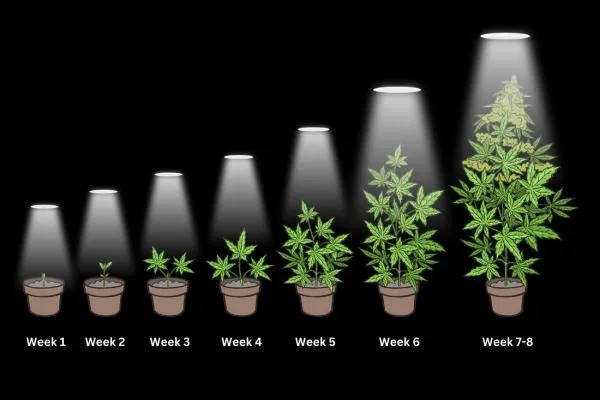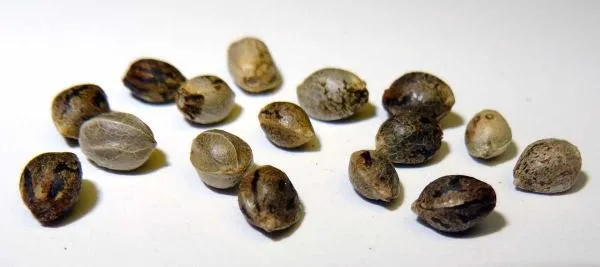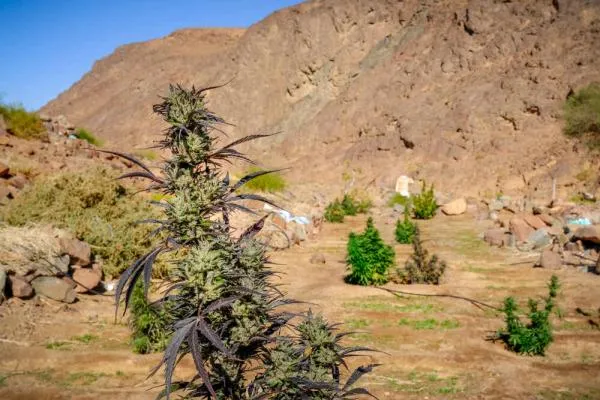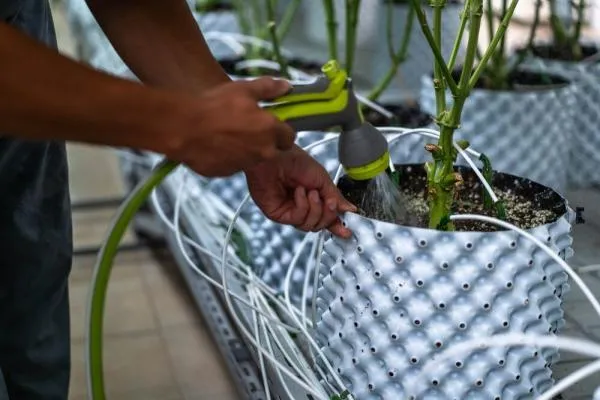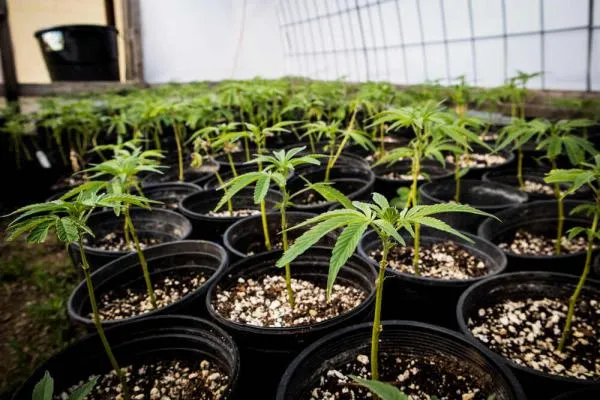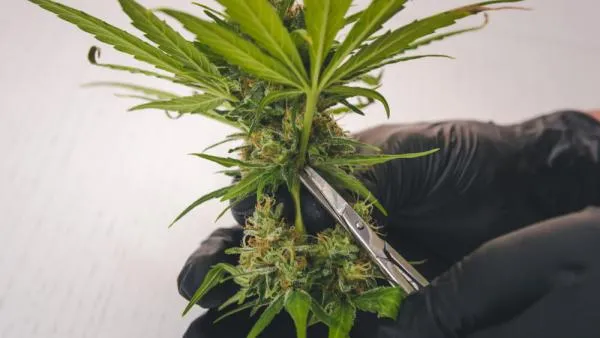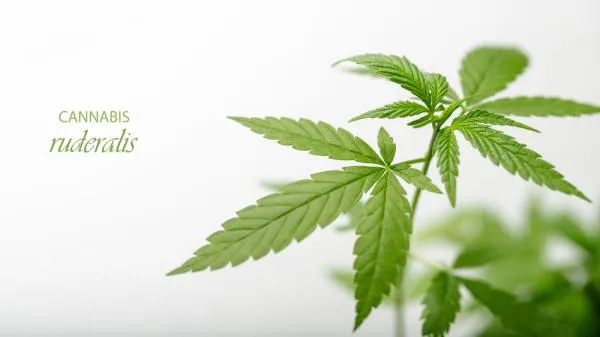Table of contents
Every springtime comes the opportunity to grow your own crops outdoors, and enjoy the fruits of your labor. With the expansion of cannabis legalization, this desire includes growing outdoor cannabis for many, too. In today’s legal markets, home growers are cultivating outdoor weed, and professional operations are as well.
So, what are the best outdoor grow setups for beginners or the best nutrients for outdoor grows that you need to know about for success? Keep reading for our ultimate guide to growing outdoor cannabis and all the best practices to help.
Indoor vs Outdoor Weed Cultivation
Outdoor weed cultivation varies greatly from indoor cultivation, especially when it comes to timing, and planning. Indoors, growers have the opportunity to cultivate crops year-round. However, growing outdoor cannabis forces cultivators to think about seasons, environments, and periods of daylight to ensure conditions are just right for top-shelf end results.
Fortunately, there are a number of benefits to growing outdoor weed, including:
- No electricity usage or specific light cycle automation is necessary. Plants receive energy from the sun.
- No manual controls over the climate with dehumidifiers, humidifiers, HVAC systems, etc.
- No space restrictions or indoor odor control, which means plants may grow larger than normal.
When growing cannabis outdoors, you will need to be conscious of the fact that plants will be more susceptible to pests, temperature fluctuations, and larger predators, too. What helps the success of outdoor weed cultivation is finding the perfect location to do so. Next, let’s review how to find the best outdoor grow setup for you.
Where Growing Outdoor Cannabis Works Best
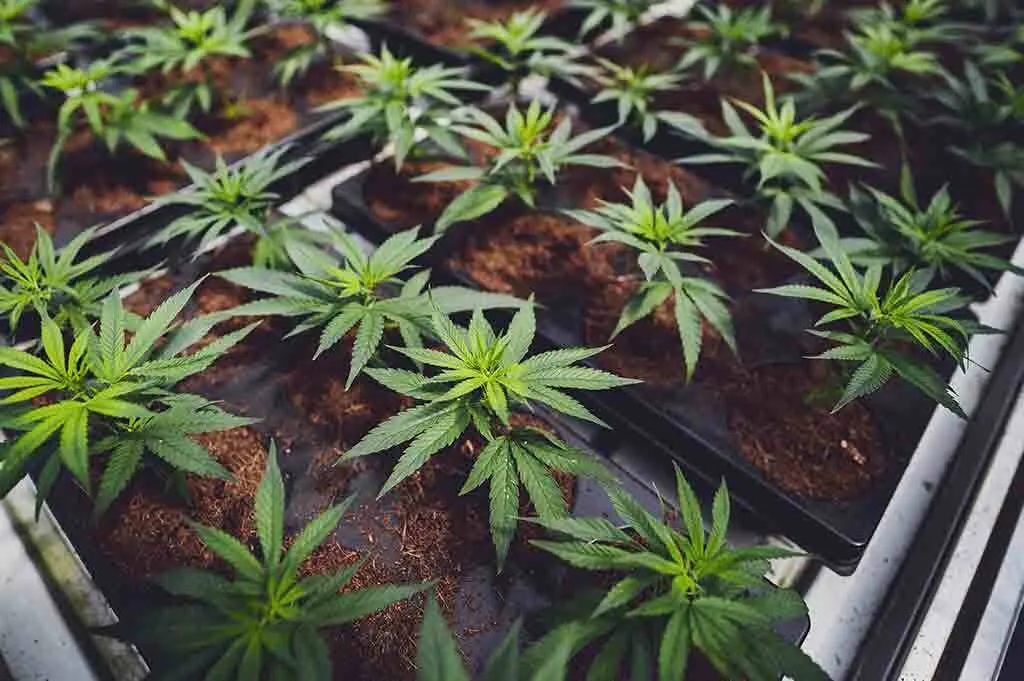
Depending on your exact location, or housing type, you’ll want to consider a few different factors for outdoor cultivation. Like, privacy, access to sunlight, accessibility for maintenance, and security, of course. Considering these factors, there are a few outdoor spaces that’ll host the best outdoor grow setups.
Below, we’ve compiled the most common areas to grow outdoors, and their individual pros and cons.
A porch or balcony
Pros -
- Easily accessible with abundant fresh air and light.
- When the building is facing the south, you’ll receive nearly all-day direct sunlight.
- Reduced electricity bills and water use associated with indoor growing.
Cons -
- Can be hard to conceal.
- High-rise buildings are subject to high-force winds.
- When the building is facing the north, you’ll receive minimal to no direct sunlight.
An open yard or space
Pros -
- Ample space for multiple plants.
- Ability to grow companion plants to deter common pest issues.
- Can be more easily hidden from public view (with fences, etc.)
Cons -
- Plants are exposed to all types of weather, storms, wind, etc.
- Increased pests, including bigger predators.
- Risk of common molds from open-air, space, and other plants in the area.
A greenhouse
Pros -
- Increased stealthiness, and protection from weather elements.
- Decreased pests, and serves as a barrier to predators.
- May lengthen the length of time you can grow outdoors, depending on the climate.
Cons -
- Can trap heat, which may cause issues like heat stress for plants.
- Increased stale air and humidity without proper ventilation or airflow.
- Depending on size, may be difficult to maneuver, feed, trim, etc.
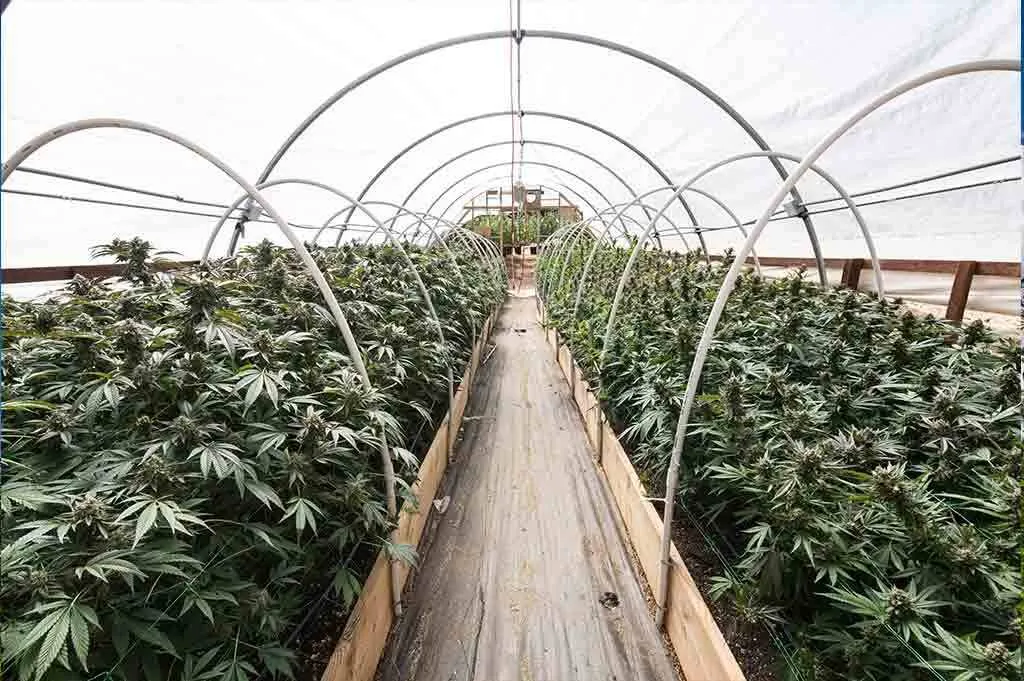
When it comes to general sun exposure, growers in the Northern Hemisphere should strive for a location with southern exposure. To receive the most available sunlight in the Southern Hemisphere, the opposite is true.
Porches, balconies, and greenhouses serve as ideal locations for their natural wind-blocking nature - unless, of course, you’re in a high-rise building where the wind forces can be stronger. While, open yards and spaces, may provide the most sunlight and energy possible. Some growers will choose to do a mix of locations, and physically move plants into portions of their yard for parts of the day, and move them into more private areas in the evening.
It’s also best to consider the temperature and climate of your outdoor space, and if you’ll have the ability to keep your plants warm with drops in temperatures, or provide shade to avoid overheating on days of excess heat. The same goes for rain and providing coverage for plants during long periods of precipitation to avoid mold growth.
All in all, now that you know the most important factors to consider for growing cannabis outdoors you can choose the best location available with the space you have. Once you do, the next choice you’ll need to make is timing your crops just right. So, let’s discuss differing climates, and seasonal timing to consider, next.
The Timing of Growing Weed Outdoors
In general, the calendar above outlines how and when growing cannabis outdoors should progress. But keep in mind, that when you’ll move plants outdoors or plant them in the ground will depend on your specific region and climate.
For instance, you should always be sure to wait until the last frost before moving your plants outdoors. In more northern regions, this may not occur until mid-late May. In that case, you may want to choose a strain that has a shorter flowering time to avoid the return of colder temperatures in the fall.
Outside of temperatures, you’ll also need to consider your region’s period of daylight or sunlight. In more northern regions, you’ll need to wait until mid-late April before you’ll capture the 12 hours of sunlight necessary for photoperiod plants to flower or bloom properly.
One of the most rewarding aspects of growing outdoor weed is reconnecting with nature and its natural cycles.To do so even more, knowing a few special dates will help time your outdoor crops just right with the seasons. Before learning the top cultivation best practices for the outdoors, let’s review those next.
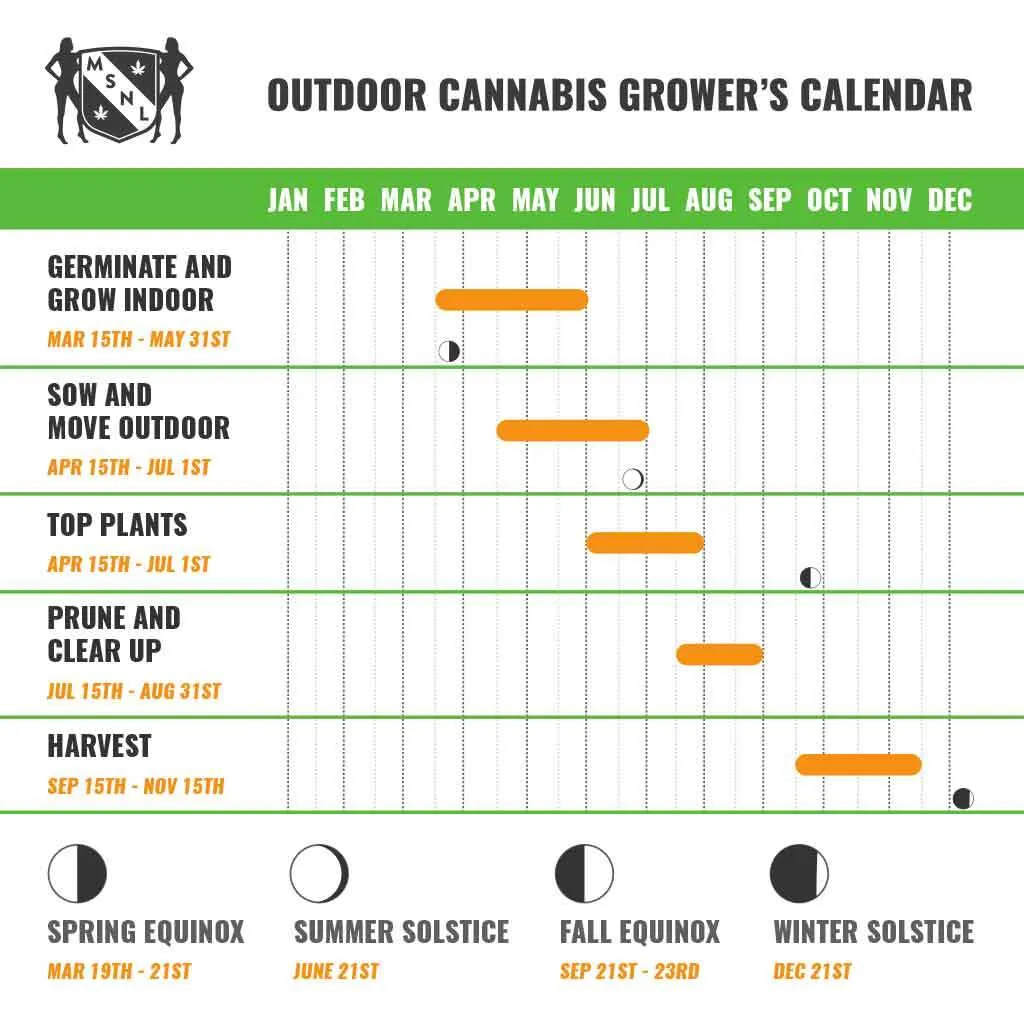
Seasonal Dates to Know for Outdoor Cultivation
Just like with other crops, there are a few seasonal dates to keep in mind for outdoor weed cultivation. Especially when considering the moon’s cycle, and the way celestial timing can influence water movements, sap production, and energy shifts to maximize quality and yields. They include:
- Spring equinox - The spring equinox occurs on March 20th and is notable for its seed germination benefits. At this time, the sun is crossing the celestial equator which notes the first official day of spring and the growing season. Many cultivators believe this signifies good luck for germinating seeds, which should take anywhere from 2-7 days.
- Summer solstice - The summer solstice occurs on June 21st and marks the time when the Earth's tilt toward the Sun is at its greatest. That means as the sun is at its highest, your plants will want to reach great heights, too. You’ll want to be sure your plants are in peak sunlight during this time, and it’s also recommended to top, defoliate, or train your plants at this time as well.
- Fall equinox - From the summer solstice to the fall equinox which occurs on September 22nd, your plants will pack on the weight as buds fatten up with resin. You’ll want to wait until at least this date to begin harvesting, and time your harvest just right before fall-time frosts set in.
Now that you have the basics of where to grow and when to grow, it’s time to get into how to grow outdoor weed. Don’t worry, our full collection of top tips and best practices for growing outdoor cannabis is coming up next.
How to Grow Outdoors & Top Tips to Know
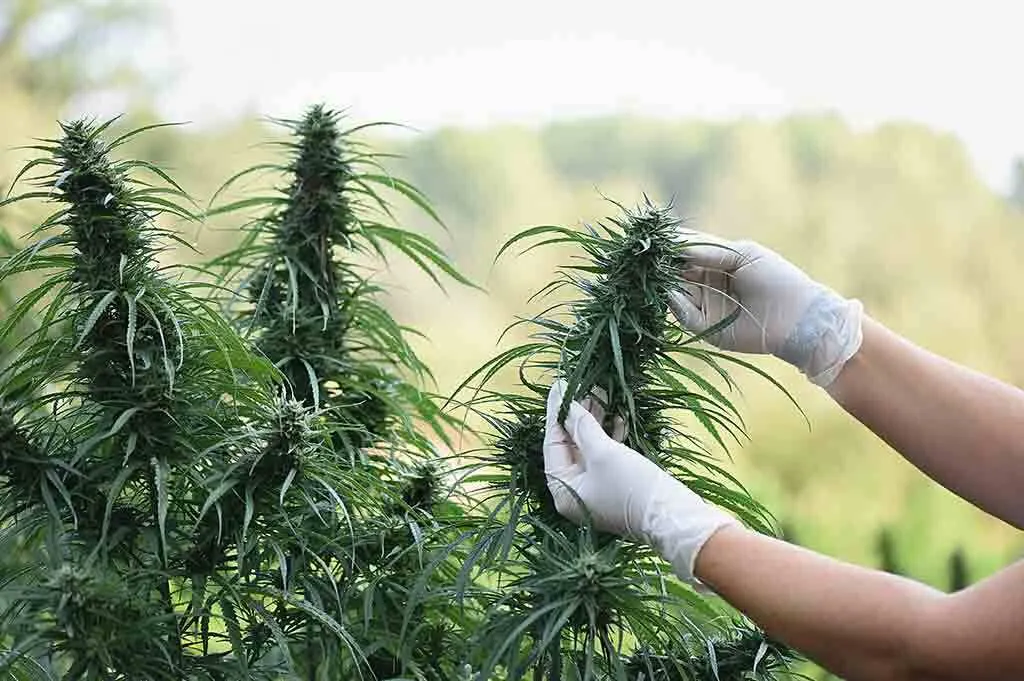
Growing outdoors can be incredibly satisfying, but also frustrating if you don’t know what you’re doing. To help, be prepared before you start with the following guide of all the tips and tricks you’ll need for success.
- Plan ahead
If you think you’ll be able to just toss some seeds in the ground, and call yourself good - think again. Growing outdoor cannabis does take some planning ahead, and thought into what you’ll grow when. That includes:
- Choose a strain that’s best for outdoor cultivation or most suitable for your unique climate. For instance, some strains will benefit from high humidity, while others are more hearty against cool temperatures. If you’re in a climate that has a shorter period of daylight, you’ll want to choose a strain that has a shorter life cycle. If you’re trying to be discrete, you may want to choose a strain that’s low-odor or has shorter heights.
- Decide whether or not you’ll grow in the ground, or in containers. Both methods have their own unique advantages and disadvantages that you’ll want to consider. Planting in the ground allows roots to grow thicker and deeper, for even stronger plant support. The larger surface area also allows a higher absorption of nutrients and water. However, when planting in the ground, you won’t be able to move the plant when necessary due to weather concerns and will need to build additional structures to prevent tumultuous conditions from harming your crops. When growing in containers, keep in mind that cannabis plants will need at least 5-gallon pots to avoid becoming rootbound and to support healthy growth.
- Timing each growth stage
Now that you know when you can move your plants outside, you’ll have to consider when to start them indoors. If you’re growing from seed, know that the seedling stage takes around two weeks before the plants move into veg.
The same goes for if you’re growing from clones. Typically, you’ll need at least four weeks of vegetative growth before plants are ready to flower. For outdoor plants, it might be smart to allow even longer for the plants to become stronger and hardier for outdoor conditions.
In general, it’s best to begin germination in March - early May to ensure your plants are ready to flower outdoors before the summer equinox arrives in June.
- Manage maintenance
Just like indoor cultivation, outdoor plants will be subject to maintenance for optimal growth and health. That includes regular watering and feeding, and training for optimal sun exposure and support. Many outdoor cultivators will prune, top, or shape their plants 1-4 times throughout their life cycle. In addition, it’ll be even more important to maintain pest management.
Predatory insects like ladybugs and jumping spiders can be introduced to your outdoor crops to fend off common detrimental pests like aphids and whiteflies. Companion planting is also another common way to prevent pest infestations. By planting basil, lemon balm, or dill nearby, you can successfully repel insects and pests. Last but not least, adding mycorrhizal fungi to your soil can help protect against harmful outdoor microorganisms, while fencing and chicken wire can be barriers for larger animals, like deer, squirrels, etc.
- Prepping for harvest
The final stage of growing outdoor cannabis is timing your harvest and prepping for the takedown of plants. After the fall equinox, growers should prepare for harvesting anywhere from mid-September to mid-November depending on the region’s climate. Outdoor plants will have the same indicators of being ready to harvest, as indoor plants. Such as transformation of color and translucency for trichomes, and pistil changes, too.
The Final Word
With this ultimate guide, now you have all the information you need to succeed when it comes to growing outdoor cannabis. So, what are you waiting for? Use the location considerations, scheduling tips, and outdoor cultivation best practices to begin your outdoor weed cultivation journey this year!

